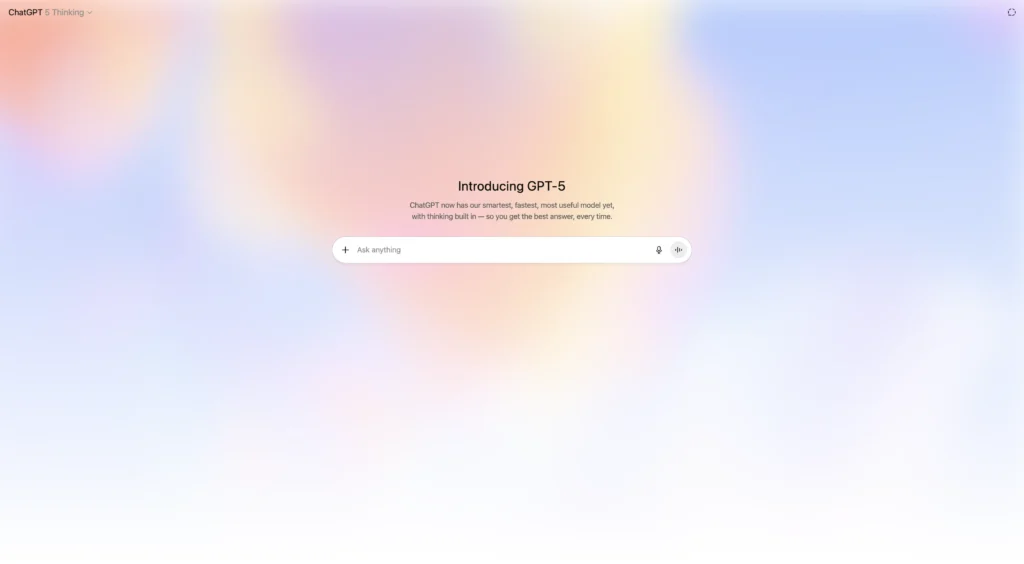GPT-5 rolled out on August 7, 2025, and it’s now the default flagship in ChatGPT—with an auto-switching system that decides when to use fast “chat” vs deeper “thinking” mode. That matters for math: algebraic manipulation, proofs, modeling, and grading all get sturdier, faster, and more controllable than earlier releases.
Below is a practical, classroom-ready guide—equal parts teacher toolkit and student survival kit—so you can turn GPT-5 into a high-leverage math co-teacher or study coach without losing the plot (or the rigor).
What’s actually new in GPT-5 (and why math folks should care)
Smarter across math: OpenAI frames GPT-5 as “smarter across the board,” with explicit callouts to better accuracy, reasoning, and problem-solving—key for symbolic steps and word-problem translation.
Auto reasoning mode: In ChatGPT, GPT-5 can switch between a fast chat model and a deeper “Thinking” model when a task benefits from careful analysis (you’ll see a slimmed reasoning view with an option to “Get a quick answer”). Translation: routine practice = quick; proofs/modeling = deeper.
API control for devs: If you build tools, the API adds knobs like
verbosityand low-effort reasoning; plus three sizes—gpt-5,gpt-5-mini,gpt-5-nano—to trade performance, latency, and cost. The chat product also exposes a distinct non-reasoning chat variant.Unified system: Under the hood, a router steers between fast and deeper models to fit the task—useful when students throw mixed workloads (explain, then calculate, then check).
Bottom line: for math, GPT-5’s combo of tighter reasoning + speed + controllability = fewer bogus steps, quicker iteration, and better “show your work” dynamics.
Golden rules for math with GPT-5 (rigor without friction)
Set the target: State the standard (AP/IB/IGCSE/GCSE, grade band) and difficulty (DOK level).
Lock the format: Ask for LaTeX or clean step lists; require final answer after steps.
Force checks: Require unit checks, reasonableness tests, and a second-method cross-check.
Bias toward hints first: Especially for students—Socratic hints > final answers.
Capture errors: Always save the “mistake log” and ask GPT-5 to cluster errors by type and prescribe drills.
These rules pair nicely with GPT-5’s chat/thinking switch: quick chat to draft items; thinking mode to verify and stress-test solutions.
For Teachers: High-leverage classroom workflows
1) Lesson blueprints in minutes (aligned + differentiated)
Prompt
“Act as a Grade 10 math teacher preparing a 55-minute lesson on completing the square. Standard: [specify]. Output:
Learning objectives (Bloom + DOK tags)
Direct instruction script (10 min) with a worked example (LaTeX)
‘I do / We do / You do’ sequence
3 misconceptions + quick diagnostics
Differentiated practice: Tier A (scaffolded), B (on-level), C (extension)
Exit ticket (2 items) with rubric (0–2). Keep explanations concise.”
Why GPT-5: It generates varied, level-appropriate problems and flags misconceptions up front. Use “Get a quick answer” for the outline, then switch to Thinking for proof-heavy segments or tricky factorization variants.
2) Problem banks with automatic guardrails
Prompt
“Create 20 original quadratic word problems, on-level Grade 9. Mix contexts (projectile motion, area, revenue). Provide: (1) clean statement, (2) solution steps (LaTeX), (3) common wrong approach and a one-line nudge to fix it. Randomize numbers; avoid plagiarism; label each with a micro-skill tag.”
Upgrade: Ask GPT-5 to generate a GIFT/QTI/LaTeX export so you can import directly into LMS/quiz engines. Then run a second pass: “Verify numeric consistency across all 20 items and re-solve one at random as a spot check.”
3) Precision feedback on student work (privacy-aware)
Prompt
“You are a grader using this rubric: [paste concise rubric]. Here are anonymized student solutions (remove names). For each, output:
Score with rubric rows
2 strengths in student voice
2 actionable, skill-level comments
1 targeted practice recommendation.”
Pro tip: Tell GPT-5 not to rewrite student work—only annotate. For large batches, the API’s gpt-5-mini is cost-friendly; switch to full gpt-5 when proofs or multi-step modeling require deeper reasoning.
4) Misconception libraries you can teach from
Ask: “List the top 12 misconceptions in fraction operations for Grade 6. For each: what students think, why it’s wrong, a 30-second demo to fix it, and an anchor problem.” Save as a living document you reuse each unit.
5) Visuals, graphs, and manipulatives on demand
Have GPT-5 draft SVG diagrams (number lines, coordinate planes, nets of solids), with clear labels and accessible alt text. For graphing tasks, ask it to describe the curve’s features (intercepts, monotonicity, extrema, asymptotes) in plain language before you show the picture—this trains students to reason before they peek.
6) Assessment, faster—and safer
Create versions A/B/C with seeded randomness to curb cheating.
Include rationales for each distractor in MCQs (e.g., the “-b vs b” trap).
Use a stress-test pass: “Attempt to break each item by proposing counterexamples or edge cases; fix any brittleness you find.”
7) Data-informed re-teaching
After a quiz, paste anonymized item-level results: “Cluster wrong answers by micro-skill; propose a 20-minute re-teach with a starter demo and 5 practice items.” GPT-5 Thinking helps spot the pattern you missed.
For Students: Study like a scientist, not a search box
1) The 30-minute daily loop
Explain it to me: “Explain implicit differentiation at a Grade 12 level; show one canonical example, then one weird edge case.”
Practice: “Give me 6 problems mixed easy → hard; hide answers.”
Self-check: Reveal one at a time. If wrong, ask: “Diagnose my error and give me a micro-drill for that exact mistake.”
Summarize: “Create 8 flashcards that target my wrong patterns only.”
GPT-5’s fast chat mode keeps this loop snappy; switch to Thinking when you truly don’t understand why a step works.
2) Socratic, not spoon-fed
Use this boundary:
“Only give hints for the next micro-step. Never jump to the final answer unless I say ‘Answer now’. If I skip algebraic justification, ask me to justify.”
This preserves the struggle that actually builds skill.
3) Word problems → equations without chaos
Prompt
“Make a variable table mapping each noun phrase to a symbol; write the equations; sanity-check units and magnitudes; then solve. Finally, restate the answer in a single sentence tied to the story.”
This reduces the classic “numbers everywhere” meltdown.
4) Proofs you can trust (and critique)
Ask GPT-5 to outline a proof first (claims/lemmas), then fill steps, then propose a counterexample search (“If any assumption fails, show a case”). You’re learning how to test a proof, not just how to copy one.
5) Build an “error portfolio”
Every time you miss, drop a snippet in a running doc. Regularly ask:
“Cluster my errors by concept vs process vs carelessness. Generate drills that target the top 2 clusters. Retest me in 72 hours.”
This is spaced repetition with receipts.
6) Calculus intuition before calculus computation
Prompt for qualitative sketches: “Describe the shape of f(x) given f′(x) and f′′(x): intervals of increase/decrease, concavity, and likely critical points; don’t calculate yet.” Then compute. Students who imagine the curve first tend to catch derivative sign mistakes earlier.
7) Sanity checks that save grades
Magnitude: “Is my answer within a plausible range?”
Units: “Track units every step; flag mismatches.”
Second method: “Solve by factoring and quadratic formula; compare.”
Back-substitute: Always.
Ready-to-use prompt library (copy/paste)
Teacher—Lesson & Practice
“Create a 45-minute Grade 8 lesson on systems of equations by substitution. Output: objectives, 1 worked example (LaTeX), 6 guided questions, 8 independent practice (mixed difficulty), 3 misconceptions with quick fixes, and a 3-item exit ticket.”
“Generate 15 original geometry problems on circle theorems. Provide clean statements, labeled diagrams (SVG), stepwise solutions, and 1 common error per item.”
Teacher—Assessments & Rubrics
“Write 10 MCQs on exponential functions, each with rationales explaining why every distractor is tempting. Provide an answer key and a LaTeX version.”
“Here’s my rubric for proof clarity. Grade these anonymized solutions with scores + two comments that are specific, kind, and actionable.”
Teacher—Re-teaching & Diagnostics
“Analyze these item-level results; identify 3 weakest micro-skills and propose a 25-minute re-teach with manipulatives and 6 fresh practice items.”
Student—Concept Mastery
“Explain completing the square like I’m 16, then like I’m a first-year math major; show what changes and why.”
“Give me 8 practice problems on rational expressions; hide answers. Reveal one at a time and diagnose my mistakes with a short drill.”
Student—Socratic Hints
“I want hints only. Ask me targeted questions. If I stall, offer the next micro-step, not the answer.”
Student—Proofs
“Outline a proof that the sum of two rational numbers is rational. Then adversarially test the outline (look for hidden assumptions) before writing the full proof.”
Student—Exam Sprint
“Simulate a 20-minute timed set on sequences/series (mixed). After, produce a heat map of my error types and a 3-day micro-plan.”
Building a math co-pilot with the API (for departments & edtech teams)
If you’re integrating GPT-5 into a school tool or departmental workflow:
Pick the right size:
gpt-5-minifor mass item generation and quick feedback;gpt-5for heavy reasoning (proof checking, multi-step modeling). A distinct non-reasoning chat variant exists for snappy UX.Tune responses with
verbosity(short vs expansive) and minimalreasoning_effortwhen latency matters (e.g., fluency drills).Tool calls: Route algebraic computations to a CAS (e.g., SymPy), keep GPT-5 for pedagogy/explanation. The model excels at chaining tool calls reliably in agentic flows.
Content safety & privacy: Keep PII out; store only what you must. Share anonymized work for grading. (OpenAI’s system card describes router + reasoning architecture so you can explain how the system behaves to admins.)
Academic integrity, safety, and fair use
Set the contract: Make a class policy on AI use: allowed for drafts, practice, error analysis; not allowed for final-answer substitution in tests.
Cite responsibly: When AI shaped your work, say so.
Accessibility: Provide text-only explanations and alt-text for visuals. GPT-5’s emphasis on structure and accuracy helps you meet those standards.
Troubleshooting & quality control
Three-pass method: (1) Solve; (2) Verify each step; (3) Stress-test with edge cases.
Ask for two methods: Algebraic vs graphical; symbolic vs numeric.
When the answer seems off: “Re-solve with a different method; explain discrepancies. If still off, state unknowns/assumptions explicitly.”
If you’re using ChatGPT directly and don’t see GPT-5 yet, it’s rolling out across tiers; Plus/Pro/Team get model pickers and access to GPT-5 Thinking/Pro variants with limits described in the Help Center.
FAQ for the SEO-curious (answering what people actually search)
What is GPT-5 (aka chat gpt 5 / chatgpt5 / gpt5 / gpt-5)?
OpenAI’s 2025 flagship model that powers ChatGPT’s new unified experience; smarter across math and reasoning, with an auto switch to a deeper “Thinking” mode when needed.
What’s the GPT-5 release date / openai gpt-5 livestream highlights?
OpenAI introduced GPT-5 on August 7, 2025 and began rolling it out to ChatGPT users and the API the same day. The company’s product pages and help docs detail capabilities and availability; if you missed the livestream, the docs summarize core improvements.
Is GPT-5 good at math?
Yes—OpenAI positions it as more accurate, faster, and better at structured reasoning. The “Thinking” mode is designed for complex analysis (proofs, multi-step modeling), while the fast mode shines for routine practice and generation.
Where can teachers/students use GPT-5?
In ChatGPT on web, iOS, Android, and desktop as it rolls out; API access is available (including gpt-5, gpt-5-mini, gpt-5-nano) for schools and edtech teams building tools.
What’s “mini” or “nano”?
They’re API model sizes (smaller = cheaper/faster). In ChatGPT, there’s also a non-reasoning chat variant separate from full reasoning models.
How does this relate to Microsoft Copilot / 365?
Many orgs integrate OpenAI’s latest models into productivity stacks; check your district’s IT guidance for current Copilot model availability. (Model availability evolves; verify with your admin.)
What about AGI and big-picture claims?
Keep the classroom grounded: use GPT-5 to accelerate practice, feedback, and exploration—then verify with math, not vibes.
What if ChatGPT is down during class?
Have an offline plan: keep a cached bank of practice sets, and export GPT-generated materials ahead of time. (Rollouts sometimes enforce rate limits; check the Help Center for current limits.)
Is there an open ai / OpenAI account requirement?
Yes. Students should follow school policies; teachers should prefer school-managed accounts to protect data.
I saw “open ai gpt 5 livestream” charts drama—does that matter?
Not for your teaching workflow. Focus on provable steps, verified answers, and reproducible materials.
One-page quick start (print this)
Teachers
Draft lesson → quick mode.
Generate practice + solutions → reasoning mode for verification.
Export LaTeX/QTI → import to LMS.
After quiz, paste results → get re-teach plan.
Keep a misconception library per unit.
Students
Explain → practice (hidden answers) → self-check.
Log every error → turn into drills.
Use hints-only mode until you’re stuck.
Ask for a second method + unit/magnitude checks.
Weekly: simulate timed sets; learn from the heat map.
Final word
GPT-5 doesn’t replace mathematical thinking; it amplifies it. Treat it like a lab partner who: drafts clean problems quickly, gives you surgical feedback, and helps you test your logic. Keep the reins: define tasks crisply, verify steps, and build students’ independent habits. That’s how you turn a shiny model into real learning gains.



